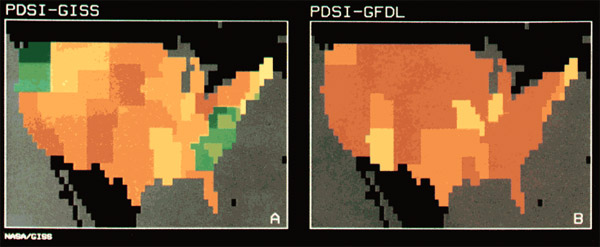The Midwest drought of 2012 has been one of the most expensive natural disasters of recent decades, with Mississippi River barge traffic on the verge of shutting down, and the Army Corps of Engineers blowing up underwater limestone to keep traffic moving:
‘If we were in the same conditions now, 30 years ago, we`d be running into problems much, much, sooner,’ Col. Hall said.
The rock removal does stop traffic for 16 hours every day. But the Coast Guard, the river`s `traffic cop`, unclogs the jam overnight.
‘During the time that the Army Corps contractors are removing rock, which is roughly 6:00am – 10:00pm at night, we gather up all the vessels that are waiting north and south,’ Capt. Teschenford said. ‘They actually do a quick survey of the area where rocks were removed and we open it up. ‘
Whenever it gets warm and dry, global warming springs to mind. But does it actually have anything to do with the drought? And should we expect more in the future? I just finished Elizabeth Kolbert's brief but widespanning Field Notes From a Catastrophe, which grew out of her New Yorker series on global warming, and it touches on the subject, based on the research of climate scientist David Rind:
He found that as carbon dioxide levels rose, the world would begin to experience more and more serious water shortages, starting near the equator and then spreading towards the poles. When he applied the GISS [Godard Institute for Space Studies] model for doubled CO2, it showed most of the continental United States would be suffering under severe drought conditions. When he applied the index to the GFDL [NOAA's Geophysical Fluid Dynamics Laboratory] model, the results were even more dire. Rind created two maps to illustrate these findings. Yellow represented a 40 to 60 percent chance of summertime drought, ochre a 60 to 80 percent chance, and brown an 80 to 100 percent chance. In the first map, showing the GISS results, the Northeast was yellow, the Midwest was ochre, and the Rocky Mountain states and California were brown. In the second, showing the GDFL results, brown covered practically the entire country.
I gave a talk based on these drought indices out in California to water-resource managers," Rind told me. "And they said, 'Well, if that happens, forget it.' There's just no way they could deal with that.
Here's America in the year 2050, produced in all its 1990 glory (PDF):

As the graphic suggests, Rind's paper is pretty old; now that we have different data and prettier maps, what does it look like?

That's the Palmer Drought Severity Index, using data from the International Panel on Climate Change. Global warming doesn't mean everywhere gets drier; the worry is that it will change medium-term weather patterns, which would change things humans have become accustomed to, like growing corn in the Midwest. Translated (PDF):
Some of these regions, such as the United States, have fortunately avoided prolonged droughts during the last 50 years mainly due to decadal variations in ENSO and other climate modes, but people living in these regions may see a switch to persistent severe droughts in the next 20–50 years, depending on how ENSO and other natural variability modulate the GHG-induced drying.
So it doesn't mean that the next 90 years or more will be all drought, all the time. It does suggest that the odds of drought will increase in the United States, particularly in the West and Midwest, and we won't always have ENSO to bail us out. Which is what people are worried about right now:
That failure to rebuild soil moisture won't happen everywhere, though. MDA EarthSat Weather senior ag meteorologist Don Keeney says though there likely won't be a "widespread wholesale reduction in drought conditions," the southern Plains, southern Midwest, Delta and Southeast will see some relief.
"I would agree that 2013 is unlikely to be an El Nino year. We are currently in a weak El Nino, and this should continue through the fall and winter, but it should weaken next spring and return to a neutral situation by later next spring. We indeed do not anticipate a widespread wholesale reduction in drought conditions, especially across the central and northern Plains and northwestern Midwest," Keeney says. "However, we cannot say that just because 2013 will not likely be an El Nino year, that this will mean a repeat of the drought that occurred this year. What this means is that El Nino or La Nina will not likely dominate U.S. weather, so this leaves the door open for many other teleconnections to dominate."
What will happen to the weather year in and year out is unpredictable, but we should be worried about our luck shifting.



